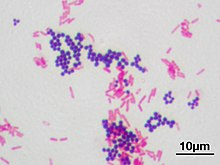
Back Gramvlek Afrikaans صبغة غرام Arabic গ্রাম রঞ্জন Bengali/Bangla Tinció de Gram Catalan Gramovo barvení Czech Gramfarvning Danish Gram-Färbung German Χρώση κατά Γκραμ Greek Gram-kolorigo Esperanto Tinción de Gram Spanish


Gram stain (Gram staining or Gram's method), is a method of staining used to classify bacterial species into two large groups: gram-positive bacteria and gram-negative bacteria. It may also be used to diagnose a fungal infection.[1] The name comes from the Danish bacteriologist Hans Christian Gram, who developed the technique in 1884.[2]
Gram staining differentiates bacteria by the chemical and physical properties of their cell walls. Gram-positive cells have a thick layer of peptidoglycan in the cell wall that retains the primary stain, crystal violet. Gram-negative cells have a thinner peptidoglycan layer that allows the crystal violet to wash out on addition of ethanol. They are stained pink or red by the counterstain,[3] commonly safranin or fuchsine. Lugol's iodine solution is always added after addition of crystal violet to strengthen the bonds of the stain with the cell membrane.
Gram staining is almost always the first step in the identification of a bacterial group. While Gram staining is a valuable diagnostic tool in both clinical and research settings, not all bacteria can be definitively classified by this technique. This gives rise to gram-variable and gram-indeterminate groups.
- ^ "Gram Stain: MedlinePlus Medical Test". medlineplus.gov.
- ^ Colco, R. (2005). "Gram Staining". Current Protocols in Microbiology. Appendix 3 (1): Appendix 3C. doi:10.1002/9780471729259.mca03cs00. ISBN 978-0471729259. PMID 18770544. S2CID 32452815.
- ^ Cite error: The named reference
Beveridge_and_Davies_1983was invoked but never defined (see the help page).
© MMXXIII Rich X Search. We shall prevail. All rights reserved. Rich X Search